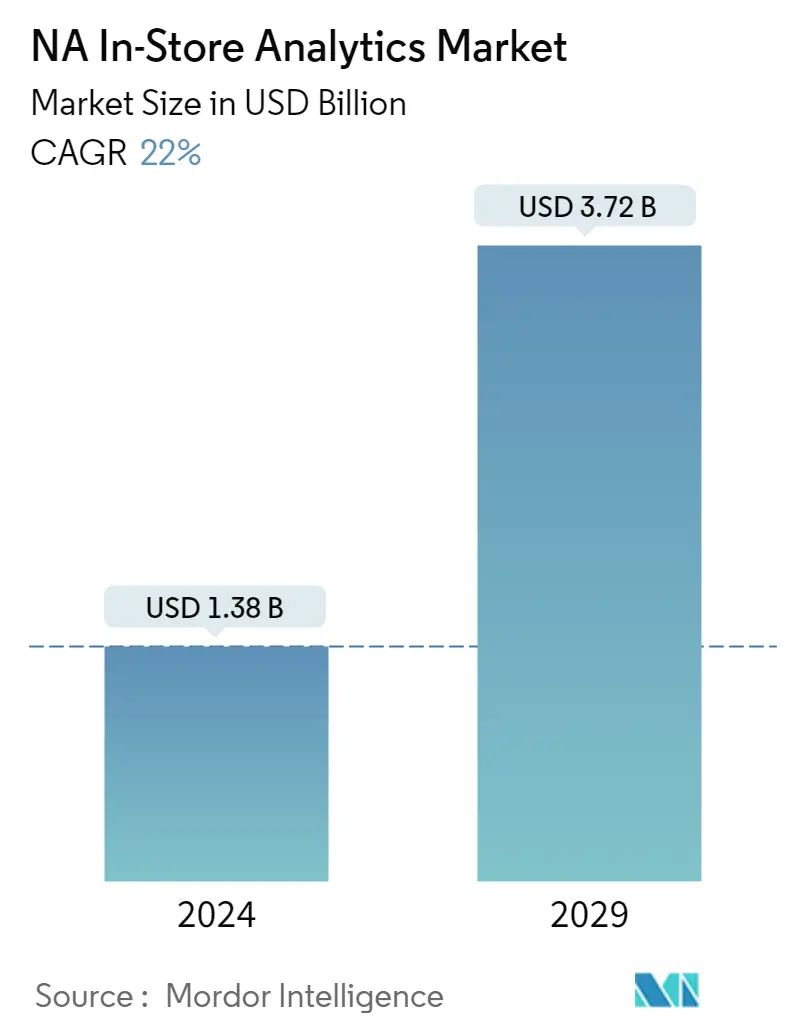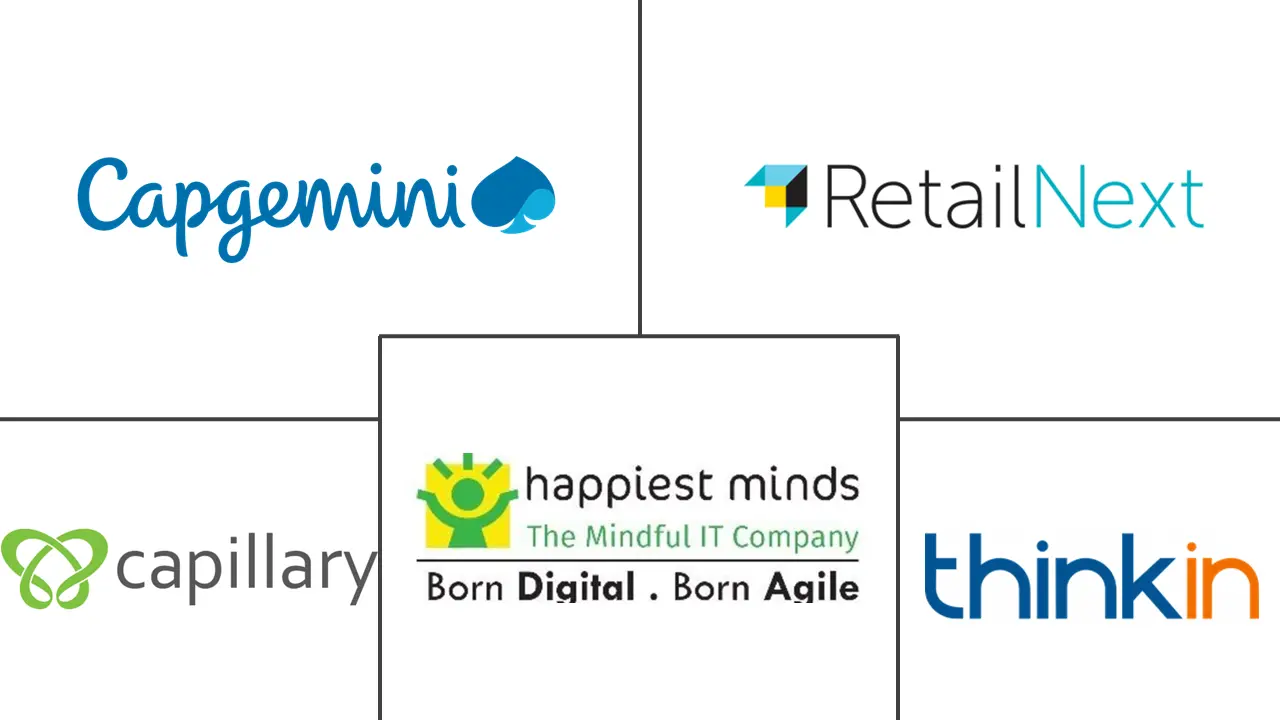Market Size of NA In-Store Analytics Industry

| Study Period | 2019 - 2029 |
| Base Year For Estimation | 2023 |
| Market Size (2024) | USD 1.38 Billion |
| Market Size (2029) | USD 3.72 Billion |
| CAGR (2024 - 2029) | 22.00 % |
| Market Concentration | Low |
Major Players
*Disclaimer: Major Players sorted in no particular order |
North America In-Store Analytics Market Analysis
The NA In-Store Analytics Market size is estimated at USD 1.38 billion in 2024, and is expected to reach USD 3.72 billion by 2029, growing at a CAGR of 22% during the forecast period (2024-2029).
Factors such as increasing data volume in in-store operations and the need For better customer service and enhanced shopping experience are expected to drive the market.
- In the hyper-competitive retail market, in-store analytics is gaining traction. In-store analytics has the potential to transform the store layout and improve customer experience across different business segments. In the North American region, retailers use smart carts with location beacons, pin-sized cameras installed near shelves, or the store's Wi-Fi network to see how many shoppers entered the store, how they moved around once inside, and what key areas they visited. This process can provide basic demographic data, such as gender and age group.
- The retail market in North America is one of the biggest. Wal-Mart, Costco, Kroger, Home Depot, and Target originated in this region. The rapidly growing data volume across in-store operations drives the market's growth. With increasing sales value, the volume of data is increasing. With growing data volume, it has become difficult to track every customer's record, behaviors, footfall, etc., without implementing analytics.
- When retailers give customized experiences to their consumers using several technologies, such as evaluating customer preferences, recognizing customer location in-store, targeted promotions, and purchase habits, they accomplish digitalization in shops. The business monitoring technology analyzes these trends to offer valuable insights that assist merchants in increasing sales, revenue, and footfalls. For example, Amazon announced the debut of its new Store Analytics service in June 2022. The e-commerce behemoth is attempting to profit from its physical storefronts by providing marketers with data on what customers buy.
- The United States Bureau of Labour Statistics estimated the demand for skilled and knowledgeable data scientists to boost by 2026, leading to a 27.9% rise in employment. However, this huge demand would also bring a significant shortage of qualified professionals. Further, another challenge to the market growth is that marketers might need to find new ways of executing their strategies in 2022 and beyond to satisfy the consumer thirst for convenience. New data privacy regulations like the California Consumer Privacy Act and Virginia's Consumer Data Privacy Act set a chain of events in motion that will heavily impact retail marketers. The third-party data that once enabled specific user targeting will no longer be available on ad platforms such as Google and Facebook. Retailers are trying to explore new ways to use first-party data in their digital marketing strategies.
- Due to the COVID-19 pandemic, the retail industry has seen significant technology adoption to manage store occupancy and screen temperatures, maintain social distancing, and streamline the use of facilities. Some of these adoptions are mandated by law, and others were made to ensure customer safety and limit store closures. Many of these technologies provided retailers with significant advantages for in-store analytics, and a much better return on investment is seen as a long-term strategic investment rather than a temporary protective measure.
North America In-Store Analytics Industry Segmentation
In-store analytics refers to the solutions and processes retailers use to measure different metrics, such as foot traffic, dwell time, and conversion rate, among others, within a retail store. Therefore, these solutions enable retailers to address key issues and increase workforce productivity, operations, and better consumer experience through merchandising, among other use cases.
The North American in-store analytics market is segmented by component (software, services), by deployment (cloud, on-premise), by organization size (large enterprises, small and medium enterprises), by application (customer management, risk & compliance management, operation management, merchandise management), and country (United States and Canada). The market sizes and forecasts are provided in terms of value (USD) for all the above segments.
| By Component | |
| Software | |
| Services |
| By Deployment | |
| Cloud | |
| On-premise |
| By Organization Size | |
| Large Enterprises | |
| Small and Medium Enterprises |
| By Application | |
| Customer Management | |
| Risk and Compliance Management | |
| Store Operation Management | |
| Marketing and Merchandizing | |
| Other Applications |
| By Country | |
| United States | |
| Canada |
NA In-Store Analytics Market Size Summary
The North America in-store analytics market is experiencing significant growth, driven by the increasing volume of data generated in retail operations and the demand for enhanced customer service and shopping experiences. Retailers in this region are leveraging advanced technologies such as smart carts, location beacons, and Wi-Fi networks to gather insights on customer behavior, including footfall, movement patterns, and demographic information. This data-driven approach is transforming store layouts and improving customer engagement across various retail segments. The market is further bolstered by the presence of major retail players like Walmart, Costco, and Target, which are continuously seeking innovative solutions to optimize their operations and enhance customer experiences. The adoption of in-store analytics is seen as a strategic investment, offering retailers a competitive edge in the rapidly evolving retail landscape.
The competitive landscape of the North America in-store analytics market is characterized by the presence of numerous software providers and technological innovations. Companies such as Capgemini, RetailNext, and Microsoft are at the forefront, offering solutions that integrate data analytics, artificial intelligence, and cloud technologies to provide retailers with actionable insights. Partnerships and collaborations, such as those between RetailNext and MarketDial, and Capgemini and Google Cloud, are enhancing the capabilities of in-store analytics solutions, enabling retailers to gain a comprehensive understanding of customer journeys and optimize their strategies accordingly. The market is also adapting to challenges such as data privacy regulations and labor shortages, with a growing focus on first-party data utilization and automation technologies. As the retail industry continues to recover and evolve post-pandemic, the demand for in-store analytics is expected to rise, supporting retailers in navigating the complexities of modern consumer behavior and market dynamics.
NA In-Store Analytics Market Size - Table of Contents
-
1. MARKET INSIGHTS
-
1.1 Market Overview
-
1.2 Industry Attractiveness - Porter's Five Forces Analysis
-
1.2.1 Threat of New Entrants
-
1.2.2 Bargaining Power of Buyers
-
1.2.3 Bargaining Power of Suppliers
-
1.2.4 Threat of Substitutes
-
1.2.5 Intensity of Competitive Rivalry
-
-
1.3 Industry Value Chain Analysis
-
1.4 Assessment of the Impact of COVID -19 on the Industry
-
-
2. MARKET SEGMENTATION
-
2.1 By Component
-
2.1.1 Software
-
2.1.2 Services
-
-
2.2 By Deployment
-
2.2.1 Cloud
-
2.2.2 On-premise
-
-
2.3 By Organization Size
-
2.3.1 Large Enterprises
-
2.3.2 Small and Medium Enterprises
-
-
2.4 By Application
-
2.4.1 Customer Management
-
2.4.2 Risk and Compliance Management
-
2.4.3 Store Operation Management
-
2.4.4 Marketing and Merchandizing
-
2.4.5 Other Applications
-
-
2.5 By Country
-
2.5.1 United States
-
2.5.2 Canada
-
-
NA In-Store Analytics Market Size FAQs
How big is the NA In-Store Analytics Market?
The NA In-Store Analytics Market size is expected to reach USD 1.38 billion in 2024 and grow at a CAGR of 22% to reach USD 3.72 billion by 2029.
What is the current NA In-Store Analytics Market size?
In 2024, the NA In-Store Analytics Market size is expected to reach USD 1.38 billion.

